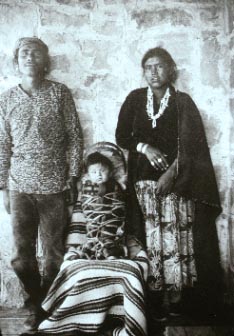Southwest - Din!e
(Navajo) Study Guide
The materials on this page are intended for use by students enrolled in
ANTH 329 North American Indians. This page and its references are periodically up-dated.
 |
| Navajo Couple |
Reading Assignments
Gill 1982: 22-25, 50-55, 62-66 and 92-97
Oswalt and Neely 1999:329-363
Suggested Video
Seasons of the Navajo, PBS Video.
Overview
The primary focus of this section will be on the Navajo, an Athabaskan people of
Arizona and New Mexico, and the Southwest culture area. Additional references will also be
made to the Papago peoples. The word, "Navajo," is likely derived from the
Pueblo peoples, meaning "enemies of the cultivated fields." It is in reference
to the hostilities that generally characterize the relationship between the two peoples.
However, the term used to refer to themselves is "Dine" (Dine'e), meaning
"earth surface people." The term "Dine" is best understood when paired
with "Yei" (Ye'ii), meaning the "Holy People" (masked Holy People),
the deities of the Dine who live in a world beneath the earth's surface.
The Navajo are a semi-nomadic, transhumance people, following a seasonal round
associated with primarily with sheep raising and maize cultivation. Their traditional
housing structure is the hogan. They conduct elaborate healing rituals, such as the
Blessing Way, involving the construction of sandpaintings. A central religious concept is
encompassed in the word, hozho and the phrase, saah naghai bikeh hozho,
words spoken in key ceremonials, such as the Blessing Way. Difficult to translate, the
phrase roughly means, "continuing re-occurring long life in an environment of beauty
and harmony," while the word, hozho, means "beauty and harmony." Hozho
is best understood in contrast to hocho, meaning "disorder." The Navajo
are known for their fine silver and turquoise jewelry and rug weaving. Navajo culture can
be described as very "adaptive," its ever-changing history characterized by its
borrowing and integration of material and cultural traits from among many of its
neighbors, such as the Pueblo, Spanish and Anglo peoples.
Key Concepts and Terms:
- Emergence Story and the Seven Worlds
- Din!e – "Earth Surface
Peoples" or Navajo – "Enemies of the Cultivated Fields"
(Pueblo word)
- Yei – "Holy Ones," also translated as
"immune." Central among the Yei are Changing Woman
and her two sons, Monster Slayer and Child of the Water. It was Changing
Woman who the other Yei conducted the first Kinaald!a
– "Walking into Beauty" ceremony (girl’s puberty ritual), and
it is Changing Women who created the Human Peoples, the Din’e.
- Bii-gi-isti – "an animating being lies within" or
"inner forms," and as expressed for Humans, "in-standing wind
soul"
- Sa#ah Nah!gi
Bik#eh H!ozh!o
– "continual reoccurring long-life in an environment of beauty and
harmony" Hozho – beauty and harmony, is contrasted with Hocho
– disorder and ugliness
- Ceremonialism and the Hataali – "singer" (medicine
man), and the "hand-tremblers" and "star gazers"
- Blessingway – maintain and restore hozho, i.e., general
well-being
- Lifeway – treat bodily, physical injury
- Holyway – infuse hozho into patient, thus removing hocho;
the largest grouping of ceremonials, includes the Beautyway and the Holyway
- Evilway – remove hocho from patient, thus restoring hozho,
i.e., treat ghost sickness, e.g, via the Enemyway
-
World View – 1. progressive movement, 2. lawful interrelatedness of the
universe (hozho), 3. knowledge is power, and 4. disorder is illness (hocho)
Self-Study Guide Questions
- Contrast the Navajo "cultural adaptability" with the Hopi "cultural
persistence." What are the various factors and considerations that account for one
tribe "embracing change" while another "tenaciously clings to
continuity?" What examples from their history can be offered to illustrate
Navajo adaptability? What is the relationship of cultural adaptability to the oral
traditions and creation account of the Navajo? Identifying the societies from which
borrowed traits came, as well as listing the major items, traits and cultural ideas
adapted into Navajo society.
- Compare Navajo and Hopi subsistence orientations. What are the implications of those
orientations on the nature of Navajo and Hopi family organizations and seasonal rounds?
- Discuss the role, symbolism and function of Navajo ceremonialism, considering prayer performance and ritual sandpainting, and placing it within the larger context of Navajo religious ideology. What is the meaning of
hozho and its significance within Navajo culture and ceremonialism?
- Discuss the structure and purposes of the Apache Sunrise Dance and the Navajo kinaaldá ceremony, and consider the role Changing Women plays in
them. Who is Changing Woman and what is her role in
Navajo culture?
- Compare and contrast the Navajo and Hopi Origin Stories.
- What were the effects on Navajo society of the federal policy of "livestock
reduction?"
- What led up to and what is the significance of the "Long Walk" in Navajo
history?
- What were the precipitating factors the lead up to the Hopi-Navajo land dispute,
comparing the problem from both a Hopi and Navajo perspective? How has it been
"resolved?"
Return to Top
You are currently viewing
http://www.uidaho.edu/~rfrey/329swnavajostudy.htm
To return to Frey's Home Page
To return to the Department of Sociology,
Anthropology and Justice Studies
To return to the University of Idaho Home Page
Page manager:rfrey@uidaho.edu


